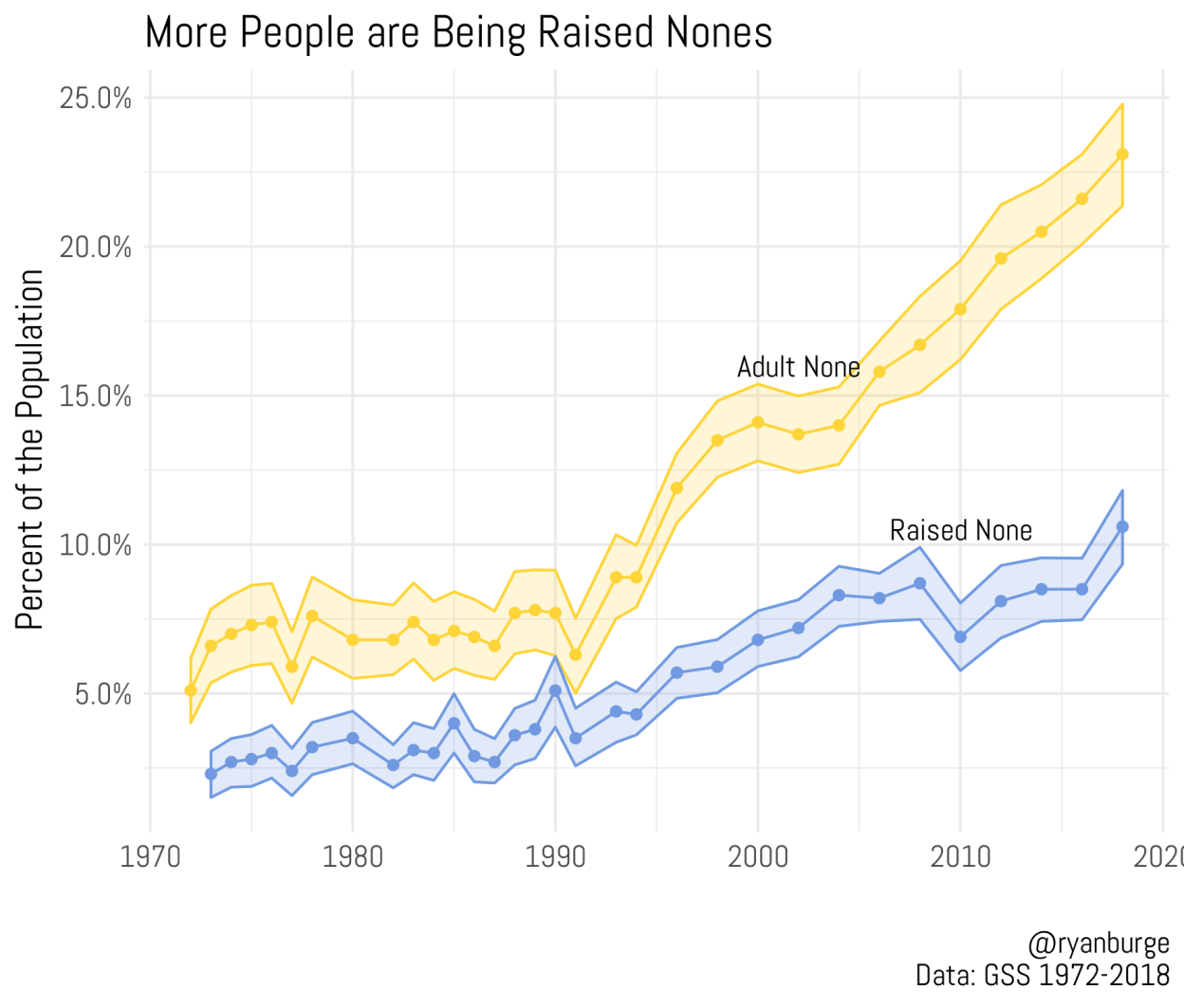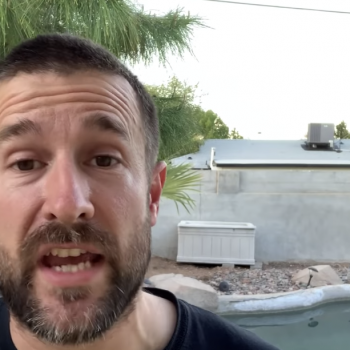If you’re a non-religious person who’s, say, older than 30, there’s a good chance you grew up in a religious family and chose to leave that faith at some point in your life. The entire genre of “New Atheist” books and blogs and videos essentially hinged on the idea that people had to break away from the idea of God.
But when we live in a nation where roughly a third of people don’t belong to any organized religion, that means we’re entering a future where more people grow up in non-religious homes. (I know, I know, my headline says “atheist.” The “Nones” are more broad than that.)
“Atheism” as a label means something to me, but that’s in large part because I escaped a religion. What happens when the bulk of atheists are actually second-generation atheists?
It’s an interesting thought experiment. Now Professor Ryan P. Burge of Eastern Illinois University has attempted to put some actual numbers to it using 2018 data from the General Social Survey.
What’s surprising to him is that while the percentage of “Nones” has gone up dramatically, that hasn’t necessarily been the case for people raised by religion. They’ve gone up, but not as much and not nearly as quickly.

… The number of adult nones nearly doubled from 1992 to 2002, while those raised nones were up about 50%. However, what might be even more interesting to me is if you look at the two lines from 2005 until 2018. In that period of time, the adult nones has risen nearly 10 percentage points, going from 14% to 23.1%. On the other hand, those raised as nones has seen a much smaller increase. In fact, if you disregard the significant bump in 2018 (which may be the start of a trend, or may be an outlier), there has been no statistically significant change in the number of people who were raised with no religion between 2006 and 2016. That’s puzzling to say the least.
There’s an obvious rebuttal here.
Those lines aren’t supposed to be in sync. It’s true the Nones doubled from about 6% in the early 1990s to about 14% in the early 2000s. However, I would argue that wasn’t a provoked, systemic change. People who left organized religion did so without any real support networks to fall back on. So even if adults left religion, many would have remained in their former churches “for the kids.”
It wasn’t until the mid-2000s that there was a huge push to get people away from religion — with more groups and resources popping up to help them out (on top of an internet-based support network). So that next huge wave of Nones from about 14% then to 23% today includes a lot more people who are open and vocal and anti-religious.
If you want to see a rise in second-generation Nones, I would think it’s their kids who would create that jump. Those are the people more likely to raise their children without religion. But, if you gave up religion in, say, 2005, and then had a child, that kid is only becoming a teenager today… and that’s at the older end of things. No one is surveying those kids.
In fact, we won’t see this shift reflected in the data for at least another 5-10 years down the line.
We simply haven’t seen a generation of people raised by parents who actively shun religion rather than just fall away from it (but still think fondly of it). And keep in mind I’m only talking about the sorts of people who had babies after leaving religion so that they raised their kids without it. (In many cases, I imagine, people who left a faith during the New Atheism boom had already raised children with religion.)
These are all generalizations, obviously, but I don’t think the chart is as puzzling as Burge does. I predict that blue line will see a sharp upward spike in the coming years.
Burge also notes that we’ve seen a change in the overall age of Nones. In 1980, for example, the non-religious were younger than the general population with a much wider average range. We were all over the place. But since then, we’ve gotten collectively older — though still a bit younger than the general population — with a lot less wiggle room. We’ve stabilized. We’re looking more and more like America at large instead of a ragtag group of rebellious kids.
The last question Burge tackles is whether Nones are as good at “retention” as religious groups. Do the children of non-religious people remain non-religious themselves or do they drift toward religion? And more importantly, how does their shift compare to that of children of Protestant or Catholic parents?
The short answer is that Nones “retain” about 65% of their kids, with another 25% drifting to Protestantism. Catholics retain 60%, with another 20% shedding religion entirely. Protestants retain (an impressive) 75%, with another 15% shedding religion. In some ways, then, it’s a wash. (I wish we knew the retention rate of atheists, specifically, but the GSS doesn’t subdivide the Nones that way. Alas.)
Burge concludes:
… those who say that they were raised with no tradition has not risen as quickly as I would have guessed. In addition, nones are getting older and are now just five years younger than the country, in general. That means that being a none is not just a young person’s fad, but it has become the reality of millions of Americans at every stage of life.
…
… this change is so new in the United States that we won’t have enough data to test it out for the foreseeable future. We are entering uncharted waters in American religion and no one really knows the way forward.
I fully agree with him here. It’ll be really fascinating to see how the rise of Nones that’s happening right now translates to younger people who grow up without religion, and what that means for our society. What happens when non-religiosity is normalized, organized faith isn’t seen as a moral authority, and church becomes something those people do rather than something we do? We won’t know for years to come.




It’s Moving Day for the Friendly ..."
It’s Moving Day for the Friendly ..."
It’s Moving Day for the Friendly ..."
It’s Moving Day for the Friendly ..."